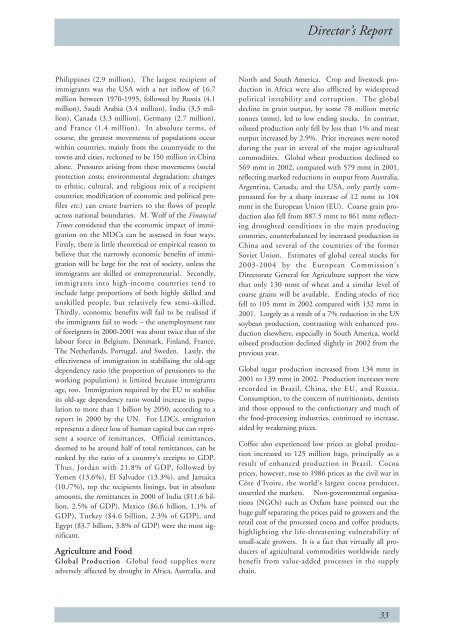PDF file: Annual Report 2002/2003 - Scottish Crop Research Institute
PDF file: Annual Report 2002/2003 - Scottish Crop Research Institute
PDF file: Annual Report 2002/2003 - Scottish Crop Research Institute
You also want an ePaper? Increase the reach of your titles
YUMPU automatically turns print PDFs into web optimized ePapers that Google loves.
Director’s <strong>Report</strong><br />
Philippines (2.9 million). The largest recipient of<br />
immigrants was the USA with a net inflow of 16.7<br />
million between 1970-1995, followed by Russia (4.1<br />
million), Saudi Arabia (3.4 million), India (3.3 million),<br />
Canada (3.3 million), Germany (2.7 million),<br />
and France (1.4 million). In absolute terms, of<br />
course, the greatest movements of populations occur<br />
within countries, mainly from the countryside to the<br />
towns and cities, reckoned to be 150 million in China<br />
alone. Pressures arising from these movements (social<br />
protection costs; environmental degradation; changes<br />
to ethnic, cultural, and religious mix of a recipient<br />
countries; modification of economic and political pro<strong>file</strong>s<br />
etc.) can create barriers to the flows of people<br />
across national boundaries. M. Wolf of the Financial<br />
Times considered that the economic impact of immigration<br />
on the MDCs can be assessed in four ways.<br />
Firstly, there is little theoretical or empirical reason to<br />
believe that the narrowly economic benefits of immigration<br />
will be large for the rest of society, unless the<br />
immigrants are skilled or entrepreneurial. Secondly,<br />
immigrants into high-income countries tend to<br />
include large proportions of both highly skilled and<br />
unskilled people, but relatively few semi-skilled.<br />
Thirdly, economic benefits will fail to be realised if<br />
the immigrants fail to work – the unemployment rate<br />
of foreigners in 2000-2001 was about twice that of the<br />
labour force in Belgium, Denmark, Finland, France,<br />
The Netherlands, Portugal, and Sweden. Lastly, the<br />
effectiveness of immigration in stabilising the old-age<br />
dependency ratio (the proportion of pensioners to the<br />
working population) is limited because immigrants<br />
age, too. Immigration required by the EU to stabilise<br />
its old-age dependency ratio would increase its population<br />
to more than 1 billion by 2050, according to a<br />
report in 2000 by the UN. For LDCs, emigration<br />
represents a direct loss of human capital but can represent<br />
a source of remittances. Official remittances,<br />
deemed to be around half of total remittances, can be<br />
ranked by the ratio of a country’s receipts to GDP.<br />
Thus, Jordan with 21.8% of GDP, followed by<br />
Yemen (13.6%), El Salvador (13.3%), and Jamaica<br />
(10./7%), top the recipients listings, but in absolute<br />
amounts, the remittances in 2000 of India ($11.6 billion,<br />
2.5% of GDP), Mexico ($6.6 billion, 1.1% of<br />
GDP), Turkey ($4.6 billion, 2.3% of GDP), and<br />
Egypt ($3.7 billion, 3.8% of GDP) were the most significant.<br />
Agriculture and Food<br />
Global Production Global food supplies were<br />
adversely affected by drought in Africa, Australia, and<br />
North and South America. <strong>Crop</strong> and livestock production<br />
in Africa were also afflicted by widespread<br />
political instability and corruption. The global<br />
decline in grain output, by some 78 million metric<br />
tonnes (mmt), led to low ending stocks. In contrast,<br />
oilseed production only fell by less than 1% and meat<br />
output increased by 2.9%. Price increases were noted<br />
during the year in several of the major agricultural<br />
commodities. Global wheat production declined to<br />
569 mmt in <strong>2002</strong>, compared with 579 mmt in 2001,<br />
reflecting marked reductions in output from Australia,<br />
Argentina, Canada, and the USA, only partly compensated<br />
for by a sharp increase of 12 mmt to 104<br />
mmt in the European Union (EU). Coarse grain production<br />
also fell from 887.5 mmt to 861 mmt reflecting<br />
droughted conditions in the main producing<br />
countries, counterbalanced by increased production in<br />
China and several of the countries of the former<br />
Soviet Union. Estimates of global cereal stocks for<br />
<strong>2003</strong>-2004 by the European Commission’s<br />
Directorate General for Agriculture support the view<br />
that only 130 mmt of wheat and a similar level of<br />
coarse grains will be available. Ending stocks of rice<br />
fell to 105 mmt in <strong>2002</strong> compared with 132 mmt in<br />
2001. Largely as a result of a 7% reduction in the US<br />
soybean production, contrasting with enhanced production<br />
elsewhere, especially in South America, world<br />
oilseed production declined slightly in <strong>2002</strong> from the<br />
previous year.<br />
Global sugar production increased from 134 mmt in<br />
2001 to 139 mmt in <strong>2002</strong>. Production increases were<br />
recorded in Brazil, China, the EU, and Russia.<br />
Consumption, to the concern of nutritionists, dentists<br />
and those opposed to the confectionary and much of<br />
the food-processing industries, continued to increase,<br />
aided by weakening prices.<br />
Coffee also experienced low prices as global production<br />
increased to 125 million bags, principally as a<br />
result of enhanced production in Brazil. Cocoa<br />
prices, however, rose to 1986 prices as the civil war in<br />
Côte d’Ivoire, the world’s largest cocoa producer,<br />
unsettled the markets. Non-governmental organisations<br />
(NGOs) such as Oxfam have pointed out the<br />
huge gulf separating the prices paid to growers and the<br />
retail cost of the processed cocoa and coffee products,<br />
highlighting the life-threatening vulnerability of<br />
small-scale growers. It is a fact that virtually all producers<br />
of agricultural commodities worldwide rarely<br />
benefit from value-added processes in the supply<br />
chain.<br />
33
















